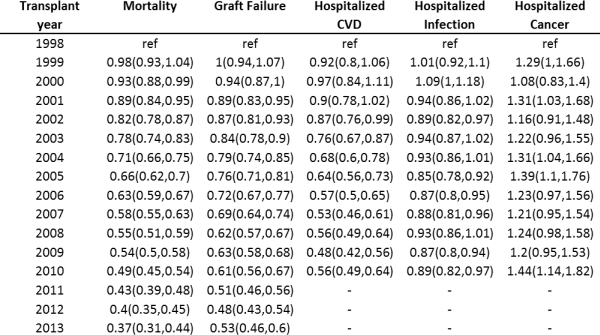Secular Trends in the Medical Complexity and Outcomes of Medicare-Insured Patients Undergoing Kidney Transplant
C. Lenihan,1 S. Liu,1 M. Montez-Rath,1 W. Winkelmayer.2
1Stanford University, Palo Alto, CA
2Baylor College of Medicine, Houston, TX.
Meeting: 2018 American Transplant Congress
Abstract number: 143
Keywords: Kidney transplantation, Outcome, Survival
Session Information
Session Name: Concurrent Session: Kidney: Cardiovascular and Metabolic - 1
Session Type: Concurrent Session
Date: Sunday, June 3, 2018
Session Time: 4:30pm-6:00pm
 Presentation Time: 5:30pm-5:42pm
Presentation Time: 5:30pm-5:42pm
Location: Room 303
Graft and patient survival following kidney transplant (KT) are improving. The reasons for this trend are unclear. We set out to examine concurrent changes in pre-KT patient complexity and cause-specific post-KT hospitalizations.
We identified 95,300 Medicare-insured patients who underwent their first KT between 1998 and 2013. We abstracted pre-KT demographic, dialysis, comorbidity and transplant data from the US Renal Data System and linked Medicare claims. We analyzed secular trends in 1) post-KT patient and graft survival, and 2) post-KT hospitalization for cardiovascular disease (CVD), infection and cancer using Cox models with year of KT as the primary exposure of interest. For the hospitalization outcomes, the cohort was truncated to between 1998 and 2010 to allow up to 3 years of Medicare-covered follow-up in all patients.
Age, dialysis vintage, BMI and the prevalence of a number of baseline medical comorbidities increased during the study. Despite these adverse changes in case mix, patient and graft survival improved: the unadjusted hazard ratios (HR) for 2013 compared to 1998 were 0.57 (CI; 0.48, 0.67) and 0.57 (CI; 0.50, 0.65), respectively. The corresponding HRs were even lower after multivariable adjustment, 0.37 (CI; 0.31, 0.44) and 0.53 (CI; 0.46, 0.6), respectively. Between 1998 and 2010, there was a marked decrease in hospitalizations for CVD in the 3 years following KT, HR 0.56 (CI; 0.49, 0.64); a modest decline in hospitalized infection, HR 0.89 (CI; 0.82, 0.97); and small increase in cancer hospitalizations, HR 1.44 (CI; 1.14, 1.82).
Adjusted* Hazard Ratios
*Adjusted for age, sex, race, cause of ESRD, dialysis vintage, dialysis modality, BMI, baseline comorbidities, and transplant factors
Our findings confirm an improvement in patient and graft survival between the years 1998 and 2013 in a large Medicare-insured KT population. Patient complexity at the time of KT increased during the study; despite this, outcomes have improved. A marked decrease in cardiovascular events and a more modest decline in infectious complications are likely to have contributed to improved survival.
CITATION INFORMATION: Lenihan C., Liu S., Montez-Rath M., Winkelmayer W. Secular Trends in the Medical Complexity and Outcomes of Medicare-Insured Patients Undergoing Kidney Transplant Am J Transplant. 2017;17 (suppl 3).
To cite this abstract in AMA style:
Lenihan C, Liu S, Montez-Rath M, Winkelmayer W. Secular Trends in the Medical Complexity and Outcomes of Medicare-Insured Patients Undergoing Kidney Transplant [abstract]. https://atcmeetingabstracts.com/abstract/secular-trends-in-the-medical-complexity-and-outcomes-of-medicare-insured-patients-undergoing-kidney-transplant/. Accessed December 23, 2025.« Back to 2018 American Transplant Congress

